Nike's journey began in 1964 as Blue Ribbon Sports, founded by Phil Knight and Bill Bowerman. It rebranded to Nike in 1971, leveraging innovative designs like the Waffle Trainer and Air Max to lead the athletic shoe market. Iconic endorsements, especially with Michael Jordan, transformed its brand into a cultural phenomenon in the realm of fashion. Despite controversies over labor practices and environmental issues, Nike adapted through sustainability efforts and strategic marketing to position itself as a fashion-forward brand. This adaptability has kept it a dominant force in the fashion industry, with revenue surpassing $46 billion in 2022. You'll see how this evolution reflects broader societal trends and impacts within the fashion landscape.
Origins of Nike

The origins of Nike illustrate a remarkable journey from a small startup to a global powerhouse in the athletic footwear industry. Founded in 1964 as Blue Ribbon Sports by Phil Knight and Bill Bowerman, the company initially focused on distributing Onitsuka Tiger shoes in the United States. This partnership laid the groundwork for what would become a revolutionary shift in the athletic shoe market.
In 1971, after parting ways with Onitsuka Tiger, the company rebranded to Nike, named after the Greek goddess of victory. This strategic move was accompanied by the introduction of the iconic Swoosh logo in 1972, designed by Carolyn Davidson, which solidified the brand's identity and appeal.
Nike's commitment to innovation was showcased with the release of the Moon Shoe in 1972, utilizing a waffle iron design for enhanced traction. By 1980, Nike had captured an impressive 50% market share in the U.S. athletic shoe market, demonstrating not only its rapid growth but also its ability to resonate with consumers. This transformation from Blue Ribbon Sports to Nike set the stage for future innovations and global dominance in the industry.
Key Innovations
Throughout its history, Nike has continually pushed the boundaries of athletic footwear innovation, markedly shaping the industry. Each key innovation not only reflects technological advancements but also demonstrates a commitment to enhancing athletic performance.
- Nike Waffle Trainer: Introduced in 1971, this shoe featured a sole inspired by Bill Bowerman's waffle iron experiment, providing superior traction and comfort for runners.
- Air Max: Launched in 1987, the Air Max line revolutionized comfort with its visible air cushioning technology, setting a new standard in both style and performance for athletic footwear.
- Vaporfly: Released in 2017, the Vaporfly series utilized innovative materials and design to improve marathon times by up to 4.2%, showcasing a significant leap in performance technology.
Other notable innovations include the Nike Cortez, a cultural icon since its debut for the Mexico Olympic Games in 1972, and the self-lacing shoes, epitomizing Nike's integration of cutting-edge technology. These advancements illustrate how Nike's relentless pursuit of innovation continues to redefine athletic footwear, enhancing comfort, performance, and style for athletes and casual wearers alike.
Athlete Endorsements
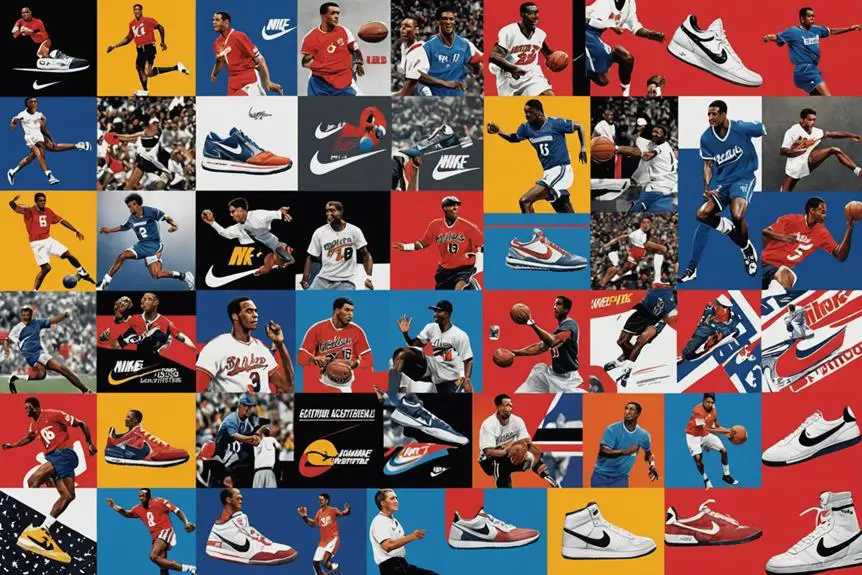
Nike's commitment to innovation extends beyond product development; it also strategically leverages athlete endorsements to amplify its brand presence. The endorsement strategy took off in 1984 when Michael Jordan signed a groundbreaking deal, resulting in the iconic Air Jordan line. This partnership not only generated over $100 million in revenue by the end of 1985 but also laid the groundwork for future collaborations. Today, Air Jordan alone netted Nike $5.1 billion in 2021, with Jordan earning substantial royalties.
Nike's portfolio includes partnerships with athletes like LeBron James and Serena Williams, enhancing brand visibility across sports. The endorsement of Colin Kaepernick in 2018 sparked media attention, contributing to reported sales growth of $6 billion post-campaign.
Here's a snapshot of Nike's impactful athlete endorsements:
| Athlete | Year Signed | Revenue Impact |
|---|---|---|
| Michael Jordan | 1984 | $100 million (1985) |
| LeBron James | 2003 | Increased visibility |
| Colin Kaepernick | 2018 | $6 billion growth |
These strategic partnerships have proven essential for Nike's sustained success in the competitive market.
Major Controversies
While Nike has built a reputation for innovation and marketing prowess, the company has not been without its share of controversies that have challenged its public image. You might find it surprising that Nike's journey is marred by significant issues, especially concerning labor practices and environmental impact. Here are three major controversies:
- Labor Practices: In the 1990s, reports of sweatshop labor in Indonesia sparked outrage, prompting activist Jeff Ballinger to highlight poor working conditions. This led to Nike implementing labor reforms, including raising the minimum age of workers.
- Tax Liabilities: The 2018 Paradise Papers revealed Nike's use of offshore companies to minimize tax liabilities, raising ethical questions about its financial strategies. This scrutiny forced the company to confront its financial transparency.
- Environmental Criticism: Nike faced backlash over the use of hazardous materials in its products. In response, it joined the Sustainable Apparel Coalition and committed to phasing out PFC products by 2021.
These controversies not only impacted Nike's public perception but also challenged the company to evolve, reflecting the complexities of corporate responsibility in today's world.
Corporate Structure
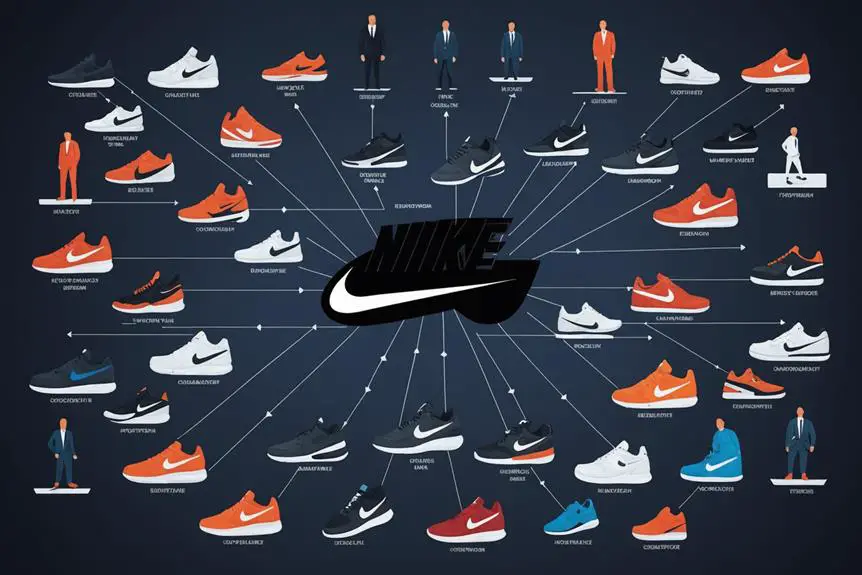
The corporate structure of Nike reflects a strategic blend of ownership and operational efficiency that has propelled the brand to its prominent position in the global market. Primarily owned by institutional investors, who control about 68% of its shares, Nike benefits from the financial stability and influence of large stakeholders like Vanguard and BlackRock. Co-founder Phil Knight retains a significant 17.4%, ensuring that the company's vision aligns with its foundational principles.
Nike operates various subsidiaries, including Air Jordan, Converse, and Hurley International, which enhance its market reach and brand diversity. This structure allows for targeted marketing and product innovation across different demographics. The corporate governance of Nike includes a board of directors that oversees strategic decisions, ensuring that shareholder interests are prioritized while maintaining operational efficiency.
In recent years, Nike has streamlined its corporate structure by focusing on core brands and divesting from several subsidiaries. This move not only enhances operational efficiency but also strengthens its global footprint, with approximately 83,700 employees worldwide. By balancing robust governance with strategic ownership, Nike continues to navigate the complexities of the global marketplace effectively.
Financial Performance
As Nike continues to navigate the complexities of the global market, its financial performance remains a demonstration of its strategic initiatives and brand strength. The company reported impressive revenue figures, exceeding $46 billion in FY 2022, reinforcing its status as a leading supplier of athletic shoes and apparel.
Key highlights of Nike's recent financial performance include:
- Sales Increase: In Q3 2024, Nike achieved a 3% sales increase to $5.07 billion, contributing to a flat sales figure of $12.43 billion for the period.
- Market Valuation: By 2023, Nike's market valuation soared to around $140 billion, establishing it as a formidable player in the retail sector.
- Regional Performance: North America accounted for 42.2% of Nike's sales, while Europe, the Middle East, and Africa made up 26.2%, showcasing its diverse market reach.
Despite announcing 1,600 job cuts, impacting 2% of its workforce, analysts raised Nike's stock outlook from neutral to buy, driven by a robust innovation pipeline and effective marketing strategies. This adaptability highlights Nike's resilience and forward-thinking approach in the ever-evolving marketplace.
Product Development
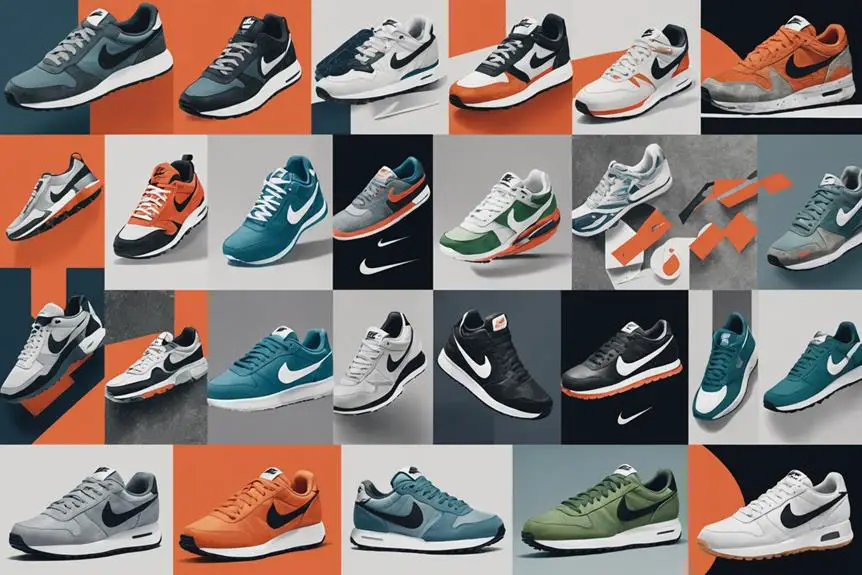
Nike's financial success is closely tied to its innovative approach to product development, which has been a cornerstone of the brand since its inception. From the very beginning, Nike set itself apart with groundbreaking designs like the Moon Shoe, created in 1972 by Bill Bowerman, which utilized a waffle iron for traction. This ingenuity sparked a revolution in running shoes with the introduction of the Waffle Trainer sole, considerably enhancing performance and comfort.
The Nike Cortez, also released in 1972, became a cultural icon after its debut at the Mexico Games, despite facing legal challenges. This adaptability to market demands has been a hallmark of Nike's product development strategy. In 2001, the Dunk SB iteration showcased this flexibility further, adapting to the needs of skateboarders with design enhancements.
Fast forward to today, and Nike continues to lead in athletic shoe technology with products like the Vaporfly series, which has improved marathon times by up to 4.2% through innovative sole design. Each step in Nike's product development reflects a commitment to innovation, setting the stage for ongoing success in an ever-evolving market.
Sustainability Efforts
Over the years, Nike has ramped up its commitment to sustainability, recognizing the pressing need to address environmental issues within the footwear industry. To enhance its eco-friendliness, the company has implemented several key initiatives:
- Nike's Grind Program: Launched in 1993, this program has recycled an impressive 28 million shoes into new products, contributing to sports surfaces and other applications.
- Reuse-A-Shoe Initiative: This initiative encourages you to return worn-out shoes for recycling, promoting a circular economy that minimizes waste.
- Sustainable Product Development: The Trash Talk Shoe, made from factory waste materials, highlights Nike's efforts to reduce environmental impact through innovative design.
Nike's commitment also extends to phasing out perfluorinated compounds (PFCs) in its products, addressing hazardous materials in production. Collaborating with the Sustainable Apparel Coalition, Nike emphasizes transparency and responsible sourcing across its supply chain. By focusing on these sustainability efforts, you're not just supporting a brand; you're participating in a broader movement toward a healthier planet. These initiatives showcase Nike's dedication to reducing its environmental footprint while still delivering high-quality products.
Cultural Impact
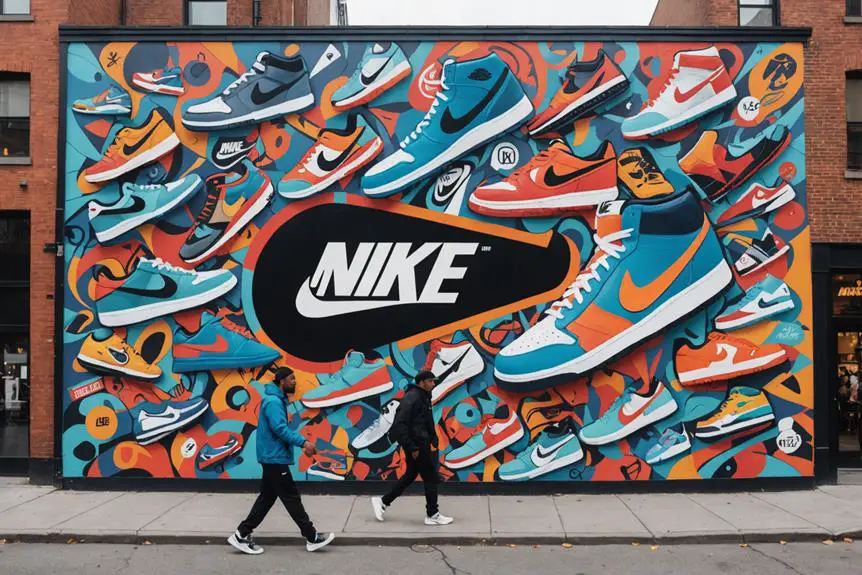
While exploring the cultural landscape shaped by Nike, you can see how the brand transcends mere footwear and apparel to influence social movements, fashion trends, and identity. Nike's "Just Do It" slogan, introduced in 1988, became a cultural mantra that inspired millions, embedding itself deep within popular culture. The launch of the Air Jordan line in 1984 with Michael Jordan sparked a cultural phenomenon, generating over $100 million in revenue by 1985 and propelling sneaker culture into mainstream consciousness.
Through innovative product designs and strategic marketing campaigns, Nike has positioned itself at the intersection of sport and lifestyle branding, becoming a status symbol in urban fashion. Collaborations with designers like Off-White's Virgil Abloh and artists like Travis Scott further amplify this status, making Nike a sought-after brand for trendsetters.
Moreover, the company's sponsorship of Colin Kaepernick ignited significant social conversations around activism and identity, resulting in a reported $6 billion sales growth. Nike's ability to engage consumers on both emotional and social levels solidifies its role as a cultural influencer, setting benchmarks that competitors aim to emulate.
Future Outlook
As the retail landscape continues to evolve, Nike stands poised to leverage its strong market valuation of approximately $140 billion in 2023 to navigate future challenges and opportunities. Despite announcing 1,600 job cuts in February 2024 to sustain profitability amid market fluctuations, Nike has shown resilience through strategic decisions. A recent sales increase of 3% to $5.07 billion in Q3 2024 highlights this adaptability.
To further cement its position in the market, consider these key strategies:
- Innovation in Product Development: Nike's commitment to cutting-edge technology will enhance its product offerings, appealing to a broader audience.
- Aggressive Marketing Strategies: By leveraging data analytics and consumer insights, Nike can tailor its campaigns to drive engagement and brand loyalty.
- Market Expansion: Continued growth in regions like China, where revenues rose by 4.5%, showcases Nike's potential for future growth.
With analysts upgrading Nike's stock outlook from neutral to buy, the focus on innovation and strategic adjustments will be critical for sustaining momentum and ensuring long-term success in an increasingly competitive market.
Frequently Asked Questions
What Is the History of Nike?
You'll find that Nike's evolution reflects a blend of innovation and strategic branding. From its humble beginnings, it transformed into a global powerhouse, driven by iconic products, memorable slogans, and a relentless pursuit of athletic excellence.
What Is the History Behind Nike Name?
The Nike name, inspired by the Greek goddess of victory, embodies excellence and athleticism. It reflects the company's commitment to empowering athletes, creating a powerful brand identity that resonates with consumers and elevates performance standards.
Who Was Nike's First Athlete?
Nike's first athlete was Steve Prefontaine, a groundbreaking middle-distance runner. His competitive edge and feedback on shoe designs not only showcased his talent but also played an essential role in Nike's brand evolution and athletic reputation.
What Are Some Interesting Facts About Nike?
Nike's innovative approach includes the Swoosh logo, the revolutionary Waffle Trainer sole, and the iconic "Just Do It" slogan. Their partnerships, especially with athletes like Michael Jordan, greatly shaped sports marketing and brand identity.
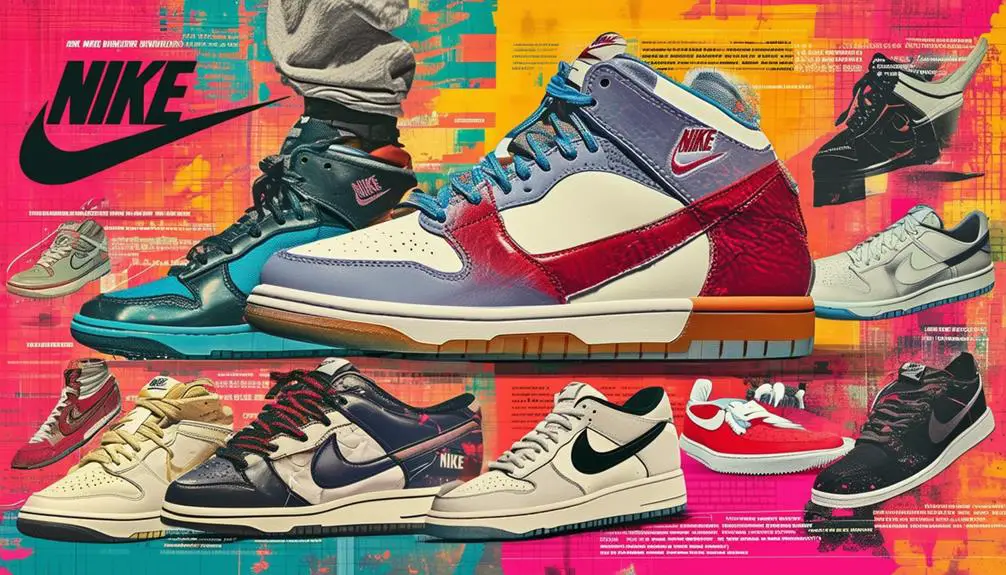



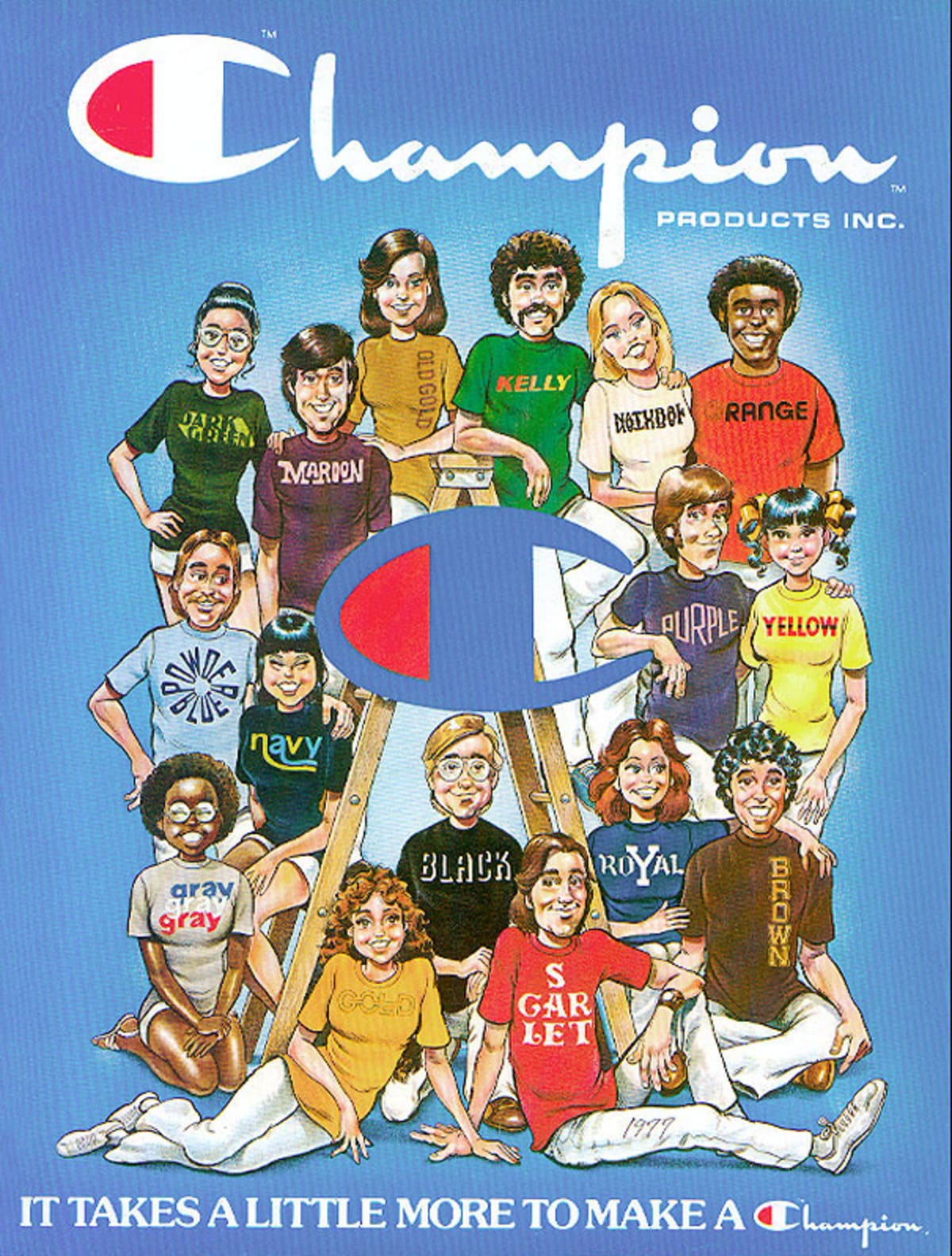
I don’t think the title of your article matches the content lol. Just kidding, mainly because I had some doubts after reading the article.
Wow, I had never thought about it in that way before You have really opened my eyes to a new perspective Keep up the great work!
Your blog stands out in a sea of generic and formulaic content Your unique voice and perspective are what keep me coming back for more
Your honesty and vulnerability in sharing your personal experiences is truly admirable It takes courage to open up and I applaud you for it
Every time I read one of your posts, I come away with something new and interesting to think about. Thanks for consistently putting out such great content!
Hi, I do believe this is an excellent web site. I stumbledupon it
😉 I am going to revisit once again since i have bookmarked it.
Money and freedom is the best way to change, may you be rich and continue to guide others.
Looking forward to your next post. Keep up the good work!
Hey There. I found your blog using msn. This is an extremely well written article.
I will make sure to bookmark it and come back to read more of
your useful info. Thanks for the post. I will
certainly return.
I’m not that much of a online reader to be honest but your blogs really nice,
keep it up! I’ll go ahead and bookmark your website to come back down the
road. All the best
Having read this I believed it was really enlightening.
I appreciate you taking the time and energy to put this
short article together. I once again find myself spending way too much time both reading and leaving comments.
But so what, it was still worth it!
Fantastic goods from you, man. I’ve understand
your stuff previous to and you are just extremely fantastic.
I actually like what you’ve acquired here, certainly
like what you’re saying and the way in which you say it.
You make it entertaining and you still care for to keep it wise.
I cant wait to read much more from you. This is really
a great web site.
bookmarked!!, I love your blog!
Hey there! Do you know if they make any plugins to assist
with Search Engine Optimization? I’m trying to get my blog to rank for some targeted keywords but I’m not seeing very
good gains. If you know of any please share. Appreciate it!
Spot on with this write-up, I honestly believe this site needs a great deal more attention. I’ll probably
be returning to read more, thanks for the info!
Normally I don’t read post on blogs, however I would like to say that this write-up very compelled
me to try and do it! Your writing style has been amazed me.
Thank you, very nice post.
Hi, I do think this is a great site. I stumbledupon it 😉 I am going to revisit yet again since i
have saved as a favorite it. Money and freedom is the greatest way to change, may you
be rich and continue to help other people.
Greetings from California! I’m bored to death at work
so I decided to check out your blog on my iphone during lunch break.
I love the information you present here and can’t wait to take
a look when I get home. I’m shocked at how quick your blog loaded on my cell phone ..
I’m not even using WIFI, just 3G .. Anyways, great blog!
Pretty! This has been an extremely wonderful post.
Many thanks for providing this information.
Great goods from you, man. I’ve take into accout your stuff prior
to and you’re simply extremely excellent. I really like what you have bought
here, really like what you’re stating and the best way through which you assert
it. You are making it entertaining and you still care for to stay it
smart. I can’t wait to learn far more from you. This is
actually a wonderful web site.
Wow, superb blog layout! How long have you been blogging for?
you made blogging look easy. The overall look of your website is fantastic, as well as the content!
What’s up friends, pleasant paragraph and fastidious urging
commented at this place, I am genuinely enjoying by these.
Genuinely when someone doesn’t be aware of afterward its up
to other users that they will assist, so here it takes place.
Amazing issues here. I am very glad to peer your article.
Thank you so much and I’m taking a look ahead to contact you.
Will you kindly drop me a mail?
This article gives clear idea for the new viewers of blogging, that in fact how to do running a blog.
Have you ever thought about writing an e-book or guest authoring on other blogs?
I have a blog based on the same subjects you discuss and would
really like to have you share some stories/information. I
know my visitors would enjoy your work. If you are even remotely
interested, feel free to send me an e mail.
Top Reinigungsfirma in München – schnell, gründlich und preiswert
This info is worth everyone’s attention. Where can I find out more?
casino united kingdom, duke nukem forever slot machine jackpot and betting usa new jersey online
casinos bonus codes, or bet online casino uk
?????? ?????? ??????
Hi there to all, how is all, I think every one is getting more from this web site, and your views
are nice in support of new people.
Have you ever considered about adding a little bit more than just
your articles? I mean, what you say is fundamental and all.
However just imagine if you added some great graphics or
video clips to give your posts more, “pop”! Your content is
excellent but with pics and clips, this website could undeniably be one of the best in its niche.
Amazing blog!
I am actually thankful to the holder of this
site who has shared this wonderful piece of writing at at this place.
https://dorogibezproblem.ru/
?????? ????? ??????????? ????
I loved as much as you’ll receive carried out right here.
The sketch is tasteful, your authored material stylish.
nonetheless, you command get bought an edginess over that you wish be delivering the following.
unwell unquestionably come more formerly again as exactly
the same nearly a lot often inside case you shield this
hike.
Your blog has helped me through some tough times and I am forever grateful for your positive and uplifting content
I’ve been browsing online more than 2 hours today, yet I never
found any interesting article like yours. It is pretty worth enough for me.
In my view, if all website owners and bloggers made good content as you did, the internet will be much more useful
than ever before.
Asking questions are in fact good thing if you are not understanding something totally, but this piece of
writing presents good understanding yet.
I have been surfing online more than 2 hours today, yet I never found any interesting article like yours.
It’s pretty worth enough for me. In my opinion, if all site owners and bloggers made good content as you did, the web will be a lot more useful than ever before.
This is very interesting, You’re a very skilled blogger.
I have joined your feed and look forward to seeking more of your excellent post.
Also, I’ve shared your web site in my social networks!
Do you mind if I quote a few of your posts as long as I provide credit and sources back to
your blog? My blog is in the very same area of interest as yours and
my users would genuinely benefit from some of the information you provide here.
Please let me know if this okay with you.
Thanks!
Highly descriptive post, I enjoyed that bit. Will there be
a part 2?
Hello to every body, it’s my first go to see of this weblog; this webpage carries amazing and genuinely fine
material for visitors.
Hi there! Would you mind if I share your blog with my myspace group?
There’s a lot of people that I think would really enjoy your content.
Please let me know. Thanks
It’s appropriate time to make some plans for the long
run and it’s time to be happy. I have learn this submit and if I could
I want to counsel you some interesting issues
or tips. Maybe you could write subsequent articles relating to this article.
I desire to read more issues approximately it!
Why viewers still make use of to read news papers when in this technological globe all is presented
on net?
I’ve been using [url=https://www.nothingbuthemp.net/products/brez-drink-lions-mane ]lions mane and thc[/url] daily in regard to on the other side of a month nowadays, and I’m justifiably impressed by the uncontested effects. They’ve helped me perceive calmer, more balanced, and less restless everywhere the day. My forty winks is deeper, I wake up refreshed, and straight my pinpoint has improved. The quality is outstanding, and I cognizant the accepted ingredients. I’ll obviously carry on buying and recommending them to the whole world I be aware!